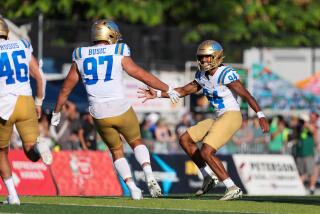Technology Cuts ‘Friendly Fire’
FALLOUJA, Iraq — Improved technology and better planning before November’s battle for Fallouja helped U.S. forces avoid the “friendly fire” casualties that have plagued other large-scale military operations, Marine Corps commanders say.
Col. John Coleman, chief of staff for the Camp Pendleton-based 1st Marine Expeditionary Force, said new technology, rushed to Fallouja within days of the battle, allowed air and ground units to know the precise location of U.S. forces in real time. Among the improvements was better intelligence gathering by ScanEagle, the unmanned reconnaissance aircraft that circled Fallouja and continuously beamed back information on U.S. forces and the location and movement of insurgents.
“I know of no blue-on-blue incidents,” said Coleman, using military parlance for cases of members of a military force mistakenly killing their own fighters.
In Fallouja, the chances for friendly-fire deaths were significant, as more than 10,000 Marines and soldiers and dozens of warplanes were involved in a crowded, fast-moving battle in an area roughly the size of a Southern California suburb.
The U.S. used several unmanned aircraft during the battle. Unheard and largely unseen, they broadcast information to forces on the ground, air units and top brass at a command post.
“It’s been a great tool for us,” Coleman said during a wide-ranging interview about Fallouja and other aspects of the Marine mission in Iraq.
Brig. Gen. Joe Dunford, assistant commander of the 1st Marine Division, said in a separate interview that, along with technological advances, good “situational awareness” among troops on the ground thanks to advance planning helped avoid friendly-fire casualties.
“Technology is an enabler, but there’s no substitute for the engagement of Marines, soldiers, sailors at all levels in good cross-talk,” Dunford said.
“I believe that the man-in-the-loop is the biggest factor in precluding blue-on-blue,” Dunford said. “Human factors outweigh technological factors.”
Coleman said some Marines might have been struck by bullets intended for insurgents, given the enormous distances that even small-caliber ordnance can travel if it misses its target. At least 72 Marines were killed during the eight-day battle. Most were killed while storming barricaded buildings where heavily armed insurgents, refusing to surrender, had taken refuge and attacked the Marines with small-arms fire.
An estimated 1,600 insurgents died. The exact number of slain militants may never be known because many of them were buried beneath the rubble of buildings demolished by U.S. firepower.
Friendly-fire casualties have been an issue for U.S. commanders for as long as the U.S. has had a military. George Washington wrote about the anguish of having his soldiers killed by their comrades after they were mistaken for British forces.
Statistics vary, but Pentagon figures suggest that friendly fire accounted for 24% of U.S. fatalities during the 1991 Persian Gulf War and 15% of the nonfatal injuries.
More recently, the Army acknowledged that former pro football player Pat Tillman might have died from friendly fire in Afghanistan when members of his special forces unit became confused and began firing at one another in the dark.
During the assault on Baghdad in the spring of 2003, as many as 10 Marines were killed near Nasiriya when their vehicles were mistakenly attacked by Air Force A-10 Thunderbolts. The incident was a virtual repeat of an incident during the Gulf War in which seven Marines were killed in an A-10 attack.
A 900-page investigative report into the Nasiriya incident blamed errors by a Marine Corps air traffic controller.
After the report, the military embarked on a crash program of developing and upgrading its battlefield information-gathering system and “cross-talk” planning.
A further complication in Fallouja was the presence of Iraqi military units. U.S. commanders made communication with the Iraqis a priority, Dunford said.
“Much of that is the result of personal upfront leadership,” he said.
In April, during the Marines’ first assault on Fallouja, two Marines were killed and nine seriously wounded when an artillery unit mistakenly fired a mortar shell at a Marine encampment.
Along with the technology and planning, U.S. forces had other advantages in November that allowed for decreasing the chances of friendly-fire deaths.
Most of the fighting was during daylight. And the U.S. had detailed maps of the city and good intelligence -- much of it provided by fleeing residents -- on the location and capability of insurgent forces, officials said.
“The result was never in question, only the timing,” he said.
More to Read
Sign up for Essential California
The most important California stories and recommendations in your inbox every morning.
You may occasionally receive promotional content from the Los Angeles Times.









